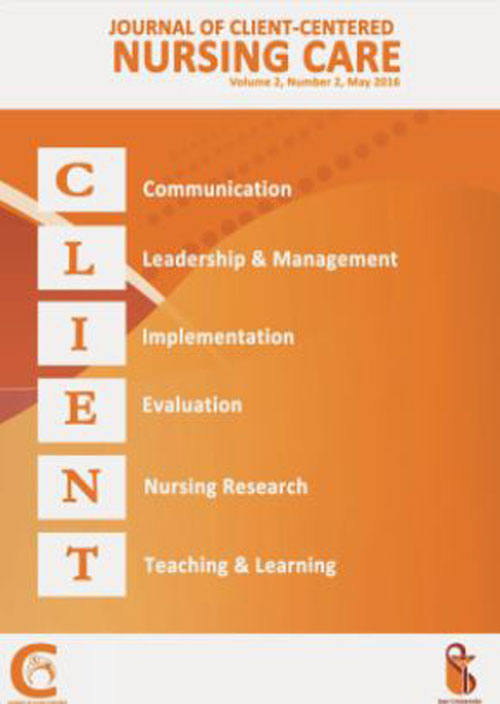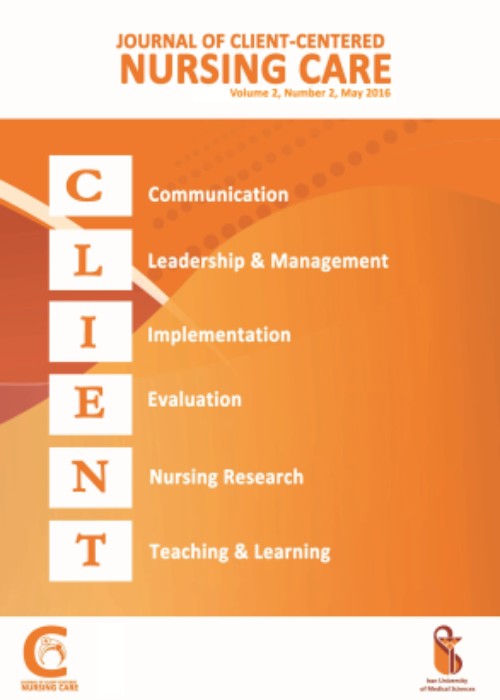فهرست مطالب

Journal of Client-Centered Nursing Care
Volume:6 Issue: 2, Spring 2020
- تاریخ انتشار: 1399/02/09
- تعداد عناوین: 8
-
-
Pages 77-78
-
Pages 79-86Background
Fatigue is one of the most prevalent and debilitating complications of cancer and its treatments. Patients undergoing radiotherapy experience some degrees of fatigue. Complementary medicine methods have reduced the complications of treatments in many disorders. Accordingly, the present study was conducted to compare the effect of aromatherapy by inhalation and massage on radiotherapy-induced fatigue in patients with cancer.
MethodsIn this randomized clinical trial, 105 patients with cancer undergoing radiotherapy in the oncology ward of Firouzgar Hospital in Tehran, Iran were selected conveniently based on the inclusion criteria and were randomly assigned into three groups of inhalation aromatherapy, massage aromatherapy, and control groups. In the first group, viola and almond oil were inhaled, in the second group, the Swedish massage was performed using aromatic oil, and the control group received routine care. Fatigue was measured by the Multidimensional Fatigue Inventory (MFI) before, and at the end of the intervention. The data were analyzed by descriptive and inferential statistics (ANOVA, Paired T-tests, Fischer’s exact, and Chi-square tests) using SPSS software V. 16. The significance level was considered as P≤0.05.
ResultsThe findings showed that the three studied groups had no significant statistical difference in terms of demographic characteristics before the intervention. Fatigue score was significantly different in all three groups after both interventions (P<0/001), which indicated a decrease in fatigue in the two test groups. However, according to Scheffe post hoc test, massage aromatherapy was more effective in reducing fatigue resulting from radiotherapy.
ConclusionThe results of this study showed that massage aromatherapy was more effective in reducing radiotherapy-induced fatigue in patients with cancer. It is recommended that future studies recruit another group that receives the only massage.
Keywords: Aromatherapy, Inhalation, Massage, Fatigue, Radiotherapy, Cancer -
Pages 87-96Background
Following the spread of new coronavirus disease (COVID-2019) in Iran, people began a new lifestyle in quarantine to survive the disease. Mother-child relationships were affected by this new lifestyle. This phenomenological study was conducted to explore the experiences of Iranian mothers in caring for their children during COVID-19 outbreak.
MethodsThis qualitative study was conducted with an interpretive phenomenological approach. The participants were selected using purposive sampling among mothers living in Tehran in 2020. The data were collected through semi-structured interviews. The participants were mothers with 7- to 9-year-old children with the experience of living in quarantine. The collected data were theoretically saturated after 17 interviews. All the interviews were recorded and transcribed, and the resulting data were analyzed using van Manen’s phenomenological approach.
ResultsFour main themes were extracted from the collected data: the mother’s health and physical concerns, confusion in playing the motherhood role, concerns about educational quality and wasting learning opportunities, and concerns about the impact of financial disputes on children.
ConclusionThe experiences of the mothers as the main caregivers in home quarantine were very unique. Understanding the complexities of their experiences, beliefs, and attitudes about motherhood and caring for children in quarantine can provide useful insights for decision-makers, healthcare professionals, and mental health professionals.
Keywords: Lived experience, Motherhood, Quarantine, COVID-19, Phenomenological study -
Pages 97-108Background
The main cause of the tendency to drug abuse among adolescents and young people is the inability to control their emotions. Previous studies have revealed that as the two models of mindfulness-based self-compassion and attachment-based therapy increase self-acceptance and forgiveness in people, they can be useful for reducing the negative emotions. The aim of the present study was to compare the effectiveness of the two models of mindfulness-based self-compassion and attachment-based therapy on the self-criticism and mental fatigue of male adolescents with addiction potential.
MethodsIt was a quasi-experimental study. The research population included all high school students in Azna County in the academic year 2018-2019. The participants were selected through cluster sampling. Those with a score above 60 on the Addiction Preparation Scale were randomly assigned to two experimental groups and one control group, each with 15 participants. The instruments used to collect the data were the Addiction Preparation Scale (Wade & Butcher, 1992), the Self-Criticism Questionnaire (Lewis, 1997), and the Psychological Fatigue Questionnaire (Crepe, 1989). The participants in the experimental groups underwent mindful self-compassion and attachment-oriented therapy for 8 and 6 sessions, respectively. The data were analyzed using Multivariate Analysis Of Covariance (MANCOVA) and one-way Analysis Of Variance (ANOVA) by SPSS software V. 21.
ResultsThe findings showed a significant difference between the experimental and control groups in terms of self-criticism (P=0.001, F=10.21) and mental fatigue (P=0.001, F=5.74) in the post-test phase. The results showed that there was no significant difference between mindful self-compassion treatment and attachment-based therapy in terms of their effects on self-criticism (-0.92±0.71, P=0.20) and mental fatigue (-0.57±0.45, P=0.19) of the male adolescents vulnerable to addiction.
ConclusionAccording to the findings of the study, it can be concluded that mindfulness-based self-compassion and attachment-based therapy are effective in reducing self-criticism and mental fatigue of male adolescents with the addiction potential. Accordingly, the models are suggested to be used by mental health professionals to help adolescents who are potential to addiction
Keywords: Addiction readiness, Self-criticism, Mental fatigue, Attachment-based therapy, Mindfulness-based self-compassion -
Pages 109-116Background
Anxiety is a common symptom in patients with the Acute Coronary Syndrome (ACS), which can threaten their quality of life. This study was done to compare the effects of aromatherapy using lavender and Benson’s relaxation technique on the anxiety of patients with ACS.
MethodsIn this randomized clinical trial, 96 patients with ACS were selected using consecutive sampling method from two hospitals in an urban area of Iran. The patients were randomly assigned to three groups of aromatherapy (n=32), Benson’s relaxation (n=32), and control (n=32) using the block size of six. The interventions were performed on two consecutive days, once a day for 20 min. Anxiety was measured before and immediately after the intervention using the Spielberger’s Anxiety Inventory. Data were analyzed using the Chi-square test, Fisher’s exact test, one-way Analysis Of Variance (ANOVA), Bonferroni post hoc test, and mixed-model repeated-measures ANOVA with a 3*2*2 design by the SPSS V. 16.
ResultsThere was no statistically significant difference in state and trait anxiety scores between the groups after the intervention on different time points (P> 0.05). The time (P=0.001), group-day interaction (P=0.005), and time (pretest and posttest) and day (P=0.029) effect on state anxiety was statistically significant. The time (P<0.001) and the group-day interaction (P<0.001) effect on trait anxiety was statistically significant.
ConclusionBenson’s relaxation method and lavender aromatherapy did not significantly reduce anxiety in patients with ACS. Considering the anxiety and its complications in patients with ACS and the importance of its management, further studies are needed to determine appropriate care and treatment for these patients and reduce their anxiety.
Keywords: Acute coronary syndrome, Anxiety, Aroma, Lavender, Muscle relaxation, Randomized controlled trial -
Pages 117-124Background
Health care services are costly and complex and provide facilities that significantly affect the economy and quality of life of individuals. In this study, we determined the gap between patients’ expectations and perceptions of hospital service quality to provide reference data for creating strategies to improve health care quality.
MethodsIn this descriptive cross-sectional study, five private hospitals in Tehran were selected. Using a simple random sampling method, 110 patients were recruited and voluntarily responded to the standard service quality (SERVQUAL) model questionnaire. Data were analyzed by the K-S test, t-test, and paired t-test using SPSS V. 23.
ResultsThe results showed that among the quality of health care components, the highest mean was related to the responsiveness (M=3.89) and the least was related to the tangible dimension (M=3.11). The lowest average quality gap (perceived service and expected service) was seen in the responsiveness dimension (2.96 and 3.28) and followed by reliability (2.66 and 3.90), tangible (2.53 and 3.91), empathy (1.36, 3.19), and assurance dimensions (2.39 and 4.75).
ConclusionThe findings revealed a significant difference between the patients’ perceived and expected services, which indicates that the quality of services as perceived by patients was lower than their expectations. According to the findings, the assurance dimension had the greatest gap. To reduce or eliminate the existing gap, it is suggested that hospitals consider strategic and operational planning to improve hospitalization experience, quality of medical services, and hospital resources.
Keywords: Quality of service, Perceptions, Expectations -
Pages 125-134Background
Clients visiting Methadone Maintenance Treatment (MMT) clinics frequently face relapse during treatment. The present study was done to investigate the relationship between family communication patterns and resiliency and craving for drugs through the mediatory role of difficulty in cognitive emotion regulation among clients treated with methadone.
MethodsThis descriptive correlational study was done on 213 drug addicts who referred to Ahvaz methadone treatment clinics in 2019, selected using convenience sampling. The research instruments included the Revised Family Communication Patterns (RFCP), the Connor-Davidson Resilience Scale (CD-RISC), the Cognitive Emotion Regulation Questionnaire (CERQ), and Craving Beliefs Questionnaire (CBQ). The proposed model was evaluated by path analysis using AMOS software.
ResultsThe results revealed a significant negative relationship between family communication patterns and the craving for drugs (P<0.01). There was a significant negative relationship between resiliency and craving for drugs in clients treated with methadone (P<0.01). Difficulties in cognitive emotion regulation had a mediating role in the relationship between family communication and resiliency with a craving for drugs (P<0.05).
ConclusionAccording to the results of this study, the proposed model had a good fit. The family communication patterns as the external and environmental factors, and resiliency as an internal and psychological factor, affect control over negative emotions and craving for drugs. Therefore, they must be considered by therapists to keep the client in the process of treatment.
Keywords: Addiction, Cognitive, Emotion, Family, Communication, Resilience -
Pages 135-144Introduction
Fazio-Londe disease is a genetic rare disorder manifesting by acute respiratory distress. This article is a case report of Fazio-Londe syndrome, its comparison with other case reports in the literature, and its patient-centered nursing care.
Case presentationIn this study, we reported a case with Fazio-Londe syndrome with respiratory distress, bulbar palsy, muscle weakness, and other symptoms.
Management and outcome: The patient was treated with oral riboflavin (100 mg/day), ribavirin (200 mg/day), and intramuscular Vit-B12 (1000 mg/day). She was managed using a patient-centered nursing care model.DiscussionHealth care providers should be aware of the new and constant symptoms of this rare disease. A patient-centered nursing care model is suggested to manage the disease.
Keywords: Fazio-londe, Nursing care, Patient-centered model of care, Brown-vialetto-van laere syndrome, Case report


